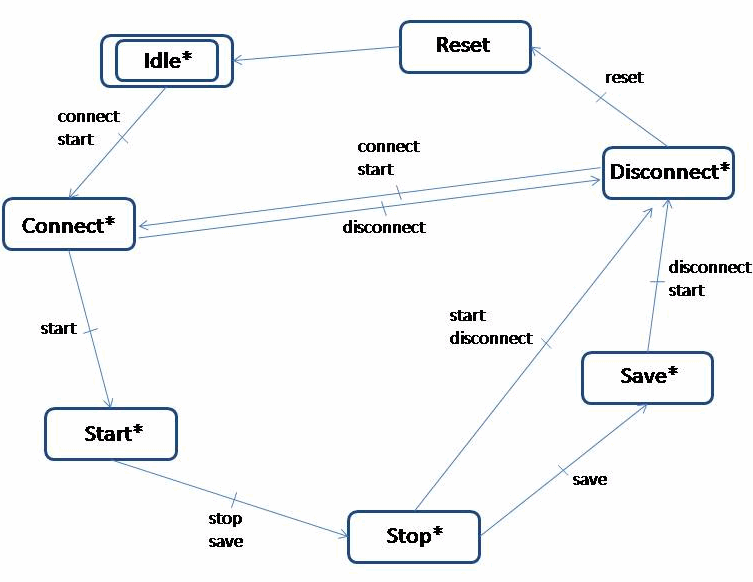FB_ScopeServerControl

The function block FB_ScopeServerControl enables the PLC to collect data for subsequent display with TwinCAT Scope 2.
 Inputs
Inputs
VAR_INPUT
sNetId : T_AmsNetId;
eReqState : E_ScopeServerState := SCOPE_SERVER_IDLE;
sConfigFile : STRING;
sSaveFile : STRING;
tTimeout : TIME := DEFAULT_ADS_TIMEOUT;
END_VARName | Type | Description |
|---|---|---|
sNetID | T_AmsNetID | A string containing the network address of the TwinCAT target system can be specified here. For the local computer an empty string may be specified. |
eReqState | Requested scope server status | |
sConfigFile | STRING | Full path with the name of the configuration file (e.g.: C:\TwinCAT\TwinCATScope2\First.sv2'). |
sSaveFile | STRING | Full path with the name of the data file (e.g.: C:\TwinCAT\TwinCATScope2\First.svd). |
tTimeout | TIME | States the length of the timeout that may not be exceeded by execution of the ADS command. |
 Outputs
Outputs
VAR_OUTPUT
bBusy : BOOL;
bDone : BOOL;
bError : BOOL;
nErrorId : UDINT;
END_VARName | Type | Description |
|---|---|---|
bBusy | BOOL | When the function block is enabled, this output is set and remains set until a feedback is received. |
bDone | BOOL | Is set if the requested status was activated. |
bError | BOOL | If an error occurs during the transmission of the command, this output is set after the bBusy output is reset. |
nErrorId | UDINT | Shows the error number if the error output bError is set. As a rule this can be an ADS error number or a specific error code of this library. |
 | Only one target system is permitted for the configuration file (*.sv2). |
State diagram:

*) to reset State Change is always possible
This state diagram shows the possible transitions for eReqState. If there is an other state change requested bError will be set.
Example:
Declaration part:
FUNCTION_BLOCK FB_ScopeServerSample
VAR_INPUT
bExternalTriggerEvent: BOOL := FALSE;
END_VAR
VAR_OUTPUT
END_VAR
VAR
fbScopeServerControl: FB_ScopeServerControl;
eReqState: E_ScopeServerState := SCOPE_SERVER_IDLE;
bBusy: BOOL := FALSE;
bDone: BOOL := FALSE;
bError: BOOL := FALSE;
nErrorId: UDINT := 0;
fbTimer: TON;
bTriggerTimer: BOOL := FALSE;
nState: UDINT := 0;
END_VARImplementation of the FB_ScopeServerSample
CASE nState OF
0:
eReqState := SCOPE_SERVER_START;
nState := 10;
10:
IF fbScopeServerControl.bDone AND bExternalTriggerEvent
THEN
bTriggerTimer := TRUE;
nState := 20;
END_IF
20:
IF fbTimer.Q THEN
eReqState := SCOPE_SERVER_SAVE;
bTriggerTimer := FALSE;
nState := 30;
END_IF
30:
IF fbScopeServerControl.bDone THEN
eReqState := SCOPE_SERVER_DISCONNECT;
END_IF
END_CASE
fbTimer(IN:=bTriggerTimer, PT:=t#10s);
fbScopeServerControl( sNetId:= '',
eReqState:= eReqState,
sConfigFile:= 'C:\twinCat\scope\test.sv2',
sSaveFile:= 'C:\twinCat\scope\test.svd',
tTimeout:= t#5s,
bBusy=>bBusy,
bDone=>bDone,
bError=>bError,
nErrorId=>nErrorId);This example demonstrates how a long-term recording with the Scope Server can be executed.
The existing configuration (Test.sv2) is loaded for this purpose. In this example Test.sv2 was stored in order to run in the ring buffer. Data logging will not finish until it is triggered by FB_ScopeServerControl. If an internal trigger event (this could be an error event) occurs, a timer is started, and 10 seconds later the data are saved in Test.svd. In this way the data file contains information from before and after the trigger event.
Requirements
Development environment | Target platform | PLC libraries to be integrated (category group) |
|---|---|---|
TwinCAT v3.1.0 | PC or CX (x86, x64, Arm®) | Tc2_Utilities (System) |